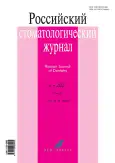Experimental and clinical study of the concentrations of chemical elements in oral fluid from prostheses and implants
- Authors: Ragulin A.V.1, Olesov E.E.1, Zhukova Y.S.2, Olesova V.N.3
-
Affiliations:
- Academy of Postgraduate Education of the Federal Scientific and Clinical Center for Specialized Types of Medical Care and Medical Technologies
- National Research Technological University MISiS
- University of Medicine and Biology for Innovation and Continuing Education of the Federal Medical Biophysical Center named after A.I. Burnazyan
- Issue: Vol 26, No 6 (2022)
- Pages: 497-501
- Section: Experimental and Theoretical Investigations
- Submitted: 06.12.2022
- Accepted: 15.12.2022
- Published: 28.02.2023
- URL: https://rjdentistry.com/1728-2802/article/view/115204
- DOI: https://doi.org/10.17816/dent115204
- ID: 115204
Cite item
Abstract
BACKGROUND: Electrochemical reactions can occur in the mouth of patients with prostheses made of metal alloys. The phenomena of galvanism reflect the hidden process of corrosion of structural alloys in oral fluid, which makes it necessary to analyze the chemical contents of prostheses under clinical conditions in patients with implants and experimental conditions.
AIM: Comparative analysis of the trace element content in the oral fluid from prostheses in implants in the clinic and an experiment.
MATERIALS AND METHODS: National Research Technological University “MISIS” analyzed artificial saliva after prostheses were in contact with grade 4 and grade 5 implants for 3 months. Titanium, cobalt, chromium, aluminum, vanadium, molybdenum, tungsten, manganese, nickel, and iron were determined by spectrometry. The same chemical elements were analyzed using an identical spectrometric method in 32 patients with fixed dentures on implants.
RESULTS: Under the experimental conditions, nine trace elements were found in the container around one grade 4 implant with a crown, including titanium (0.4 µg/l), cobalt (3.8 µg/l), chromium (0.5 µg/l), aluminum (2.6 µg/l), vanadium (<0.6 µg/l), molybdenum (1.5 µg/l), tungsten (3.0 µg/l), manganese (0.9 µg/l), nickel (0.5 µg/l), and iron (<0.6 µg/l). The grade 5 implant was characterized by a greater degree of diffusion of aluminum, nickel, and manganese into artificial saliva. Mass spectrometry of the oral fluid in patients with dental implants revealed more trace elements than experimental data. The difference in the concentration of microelements from the prostheses under clinical conditions and in the experiment ranged from 0 to 128 times the minimum.
CONCLUSION: Fixing experimental prostheses on implants for 3 months in artificial saliva was accompanied by the diffusion of microelements from the prostheses and implants into the environment, particularly cobalt, aluminum, and vanadium. Prostheses on implants with a lower titanium content are characterized by a greater degree of diffusion of aluminum, cobalt, nickel, and manganese. More significant diffusion of microelements occurred from the prostheses into the saliva under clinical conditions, according to the spectrometric data.
Keywords
Full Text
About the authors
Arseniy V. Ragulin
Academy of Postgraduate Education of the Federal Scientific and Clinical Center for Specialized Types of Medical Care and Medical Technologies
Author for correspondence.
Email: senya12_95@mail.ru
ORCID iD: 0000-0003-0799-4688
Postgraduate Student
Russian Federation, 15, bldg. 1, Gamaleya street, Moscow 123098Egor E. Olesov
Academy of Postgraduate Education of the Federal Scientific and Clinical Center for Specialized Types of Medical Care and Medical Technologies
Email: olesov_georgiy@mail.ru
ORCID iD: 0000-0001-9165-2554
MD, Dr. Sci. (Med.), Associate Professor
Russian Federation, MoscowYulia S. Zhukova
National Research Technological University MISiS
Email: yulia.s.zhukova@gmail.com
ORCID iD: 0000-0003-2732-5545
Leading Researcher
Russian Federation, MoscowValentina N. Olesova
University of Medicine and Biology for Innovation and Continuing Education of the Federal Medical Biophysical Center named after A.I. Burnazyan
Email: olesova@implantat.ru
ORCID iD: 0000-0002-3461-9317
MD, Dr. Sci. (Med.), Professor
Russian Federation, MoscowReferences
- Lebedenko IYu, Arutyunov SD, Ryakhovsky AN, editors. Orthopedic dentistry: national leadership. Moscow: GEOTAR-Media; 2022. 520 p. (In Russ).
- Kulakov AA, editor. Dental implantation: national leadership. Moscow: GEOTAR-Media; 2018. 400 p. (In Russ).
- Makeeva IM, Volkov AG, Dikopova NZh, Makarenko NV. The determination of electrochemical potentials in the oral cavity, as a way to diagnose galvanic syndrome, which contributes to the development of diseases of the mucous membrane. Head and Neck. Russian Journal. 2018;6(1):42–45. (In Russ). doi: 10.25792/HN.2018.6.1.42-45
- Manin OI, Otyrba RD, Prokopova MA. The study of galvanic phenomena in patients with oral candidiasis. Proceedings of the 7th International Scientific and Practical Conference “Stomatologiya slavyanskikh gosudarstv”. Belgorod; 2014. P:248–250. (In Russ).
- Musheev IU. Experimental electrochemical characteristics of titanium implants and prostheses. Materials of the 5th All-Russian scientific and practical conference “Obrazovaniye, nauka i praktika v stomatologii” on the united topic “Implantology in dentistry”. Moscow; 2008. P:71–73. (In Russ).
- Ragulin AV, Sereda AE, Olesov EE, et al. The content of microelements in the oral fluid of users with fixed prostheses on implants. Russian Bulletin of Dental Implantology. 2022;55-56(1-2):72–77. (In Russ).
- Ragulin AV, Kurnikov AV, Kashchenko PV, et al. Detection of structural microelements of dentures in the oral fluid. Conference materials “Il’inskiye chteniya”. Moscow; 2022. P:208–209. (In Russ).
- Ragulin AV, Sereda AE, Kairbekov RD. Analysis of trace elements of the chemical composition of implants and metal-ceramic prostheses in the oral fluid. Proceedings of the III Scientific and Practical Conference of Young Scientists with International Participation. Moscow; 2022. P:3–5. (In Russ).
Supplementary files







